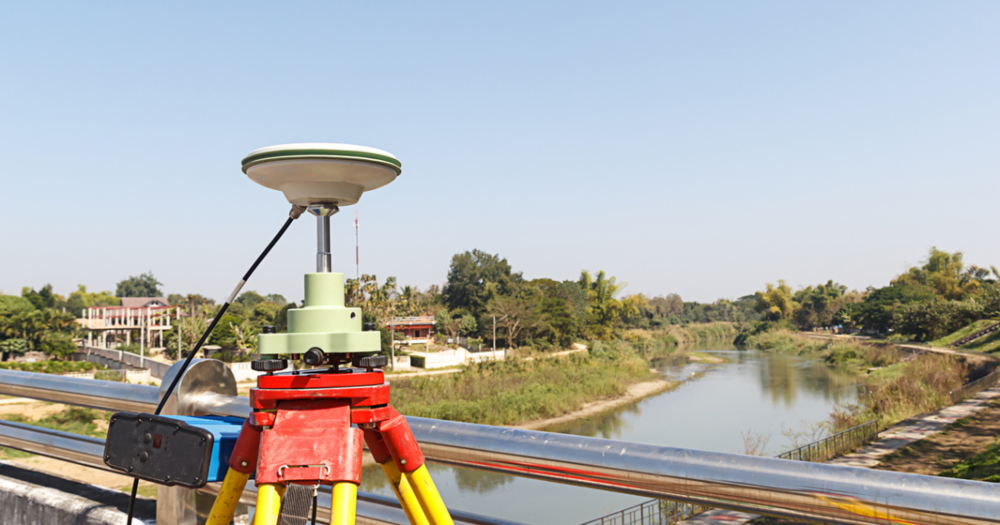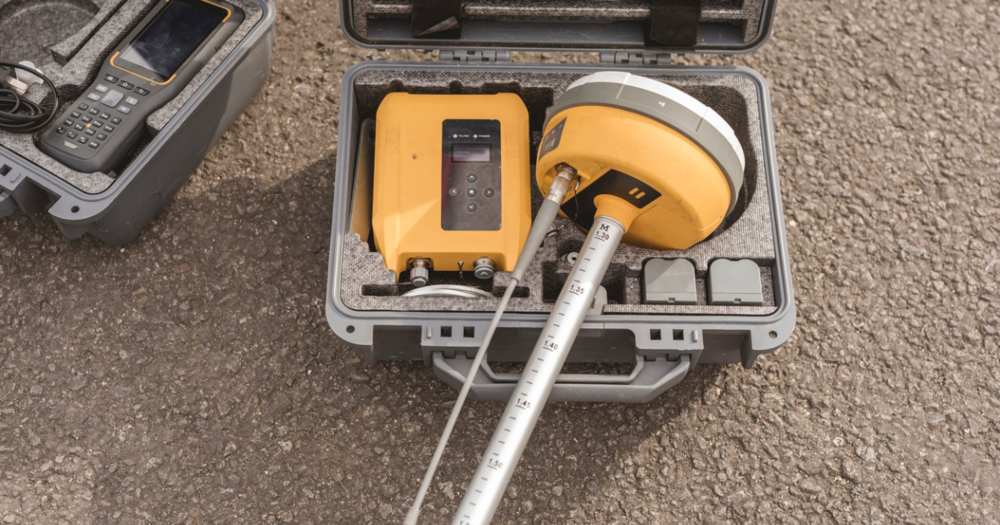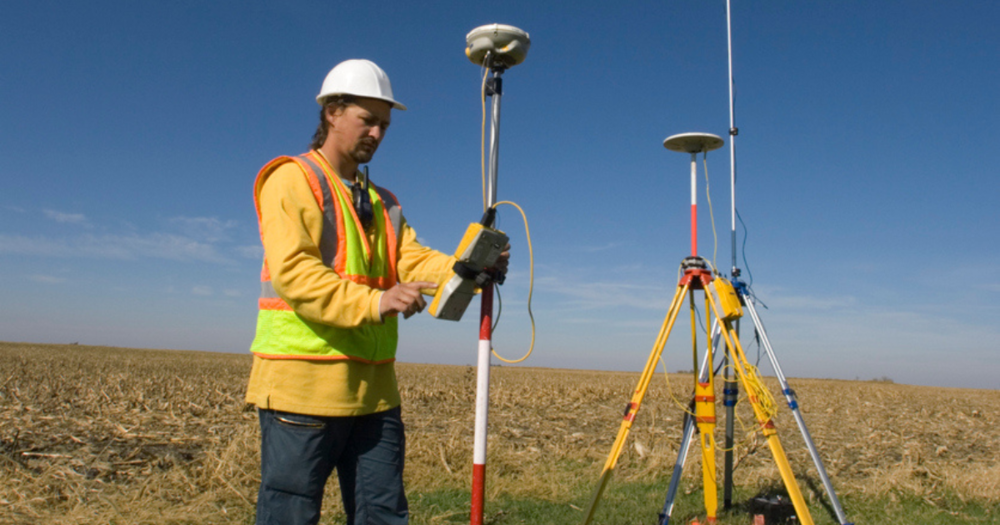
GPS equipment maintenance is not just about keeping your devices clean and functional. It’s about extending their lifespan, preventing costly downtime, and verifying every measurement you take is as precise as possible.
Let’s begin with a quick checklist for routine inspections and upkeep.
Routine GPS Equipment Maintenance and Inspections
Whether you have a
GPS, DGPS, or RTK unit, regular inspections keep them in optimal working condition to deliver accurate results.
Here’s how to conduct a few routine inspections:
Visual Inspection
- Check for wear and tear: Examine the exterior of the GPS unit for any signs of physical damage, such as cracks, dents, or scratches. Pay special attention to areas that are frequently handled.
- Inspect connectors and ports: Look at all connectors, ports, and cables for signs of wear, corrosion, or damage. Verify all connections are secure and free from debris.
- Evaluate buttons and controls: Test them to check that they function correctly. Look for any sticking or unresponsive buttons that may need attention.
Functional Testing
- Power on/off: Test the power button to see if the device powers on and off without issues. Observe the startup sequence for any error messages or abnormal behavior.
- Battery check: Verify the battery's condition by checking its charge levels and performance. Replace batteries that show signs of degradation, such as quick depletion or swelling.
- Screen and display: Inspect the screen for dead pixels, discoloration, or cracks. Make sure that the display is clear and all menus and interfaces are accessible.
Operational Check
- GPS signal reception: Test the unit's ability to acquire satellite signals and maintain a stable connection. Verify that it provides accurate location data.
- Data storage: Check the device's internal and external storage for available space and proper functioning. Check that data is being saved correctly and can be retrieved without errors.
- Software and firmware: Look for any available updates from the manufacturer and install them as needed.
Now let’s dive deeper into each of these steps.
Cleaning and Protection

Keeping your
GPS units free from dust, dirt, and debris is essential for optimal performance and longevity.
Regular Cleaning
Dust and grime can interfere with your device's screen, buttons, and connectors, leading to inaccuracies and potential malfunctions.
To maintain your device's functionality, follow these best practices for cleaning:
- Clean the screen: Use a soft, lint-free cloth or a microfiber cloth dampened with water or a mild alcohol solution to wipe the screen gently. Avoid harsh chemicals or abrasive materials, which can damage the screen's surface.
- Clean the connectors: Dust and dirt can accumulate in the connectors, causing connectivity issues. Use a small, soft brush or compressed air to remove debris from these areas without damaging the delicate pins.
- Clean the casing: Wipe down your GPS unit's exterior casing with a damp cloth to remove dust and dirt. Check that no moisture can enter the device through openings.
- Conduct a physical inspection: Regularly inspect your GPS unit for signs of wear and tear. Look for cracks, loose parts, or other damages that require attention.
Environmental Protection
Protecting your GPS devices from extreme weather conditions is crucial for their longevity. Here are some tips to safeguard your equipment:
- Extreme weather protection: High temperatures can cause your device to overheat, while freezing conditions can lead to condensation and internal damage. Avoid exposing your GPS equipment to extreme temperatures whenever possible.
- Protective cases and covers: Invest in high-quality protective cases and covers designed for GPS units. These accessories can shield the device from impacts, scratches, physical damage, and temperature extremes.
We offer various surveying instrument backpacks, hard cases, and soft cases that protect your GPS unit and provide convenient carrying solutions for fieldwork.
Avoiding Moisture
Moisture is one of the primary enemies of electronic devices, including GPS units. Keeping your device dry is essential to prevent internal damage and provide reliable performance.
Here are some strategies to manage moisture:
- Waterproofing solutions: If your GPS unit is used in environments prone to rain or water exposure, utilize waterproof cases or pouches.
- Desiccants for moisture control: Store your GPS unit with desiccants, such as silica gel packets, to absorb residual moisture.
- Immediate action for wet devices: If the GPS unit gets wet, turn it off immediately and remove the battery if possible. Dry the device thoroughly using a soft cloth and allow it to air dry in a warm, dry place. Avoid using heat sources like hair dryers since they can cause further damage.
Our GPS equipment hard cases are excellent options to protect against water ingress, ensuring your device stays dry.
Software and Firmware Updates
Verifying that your GPS devices have the latest updates is not just about performance – it also extends the equipment's lifespan. Updated software can optimize the device's power consumption and processing efficiency, reducing wear and tear on the hardware components.
Regular Update Checks
Regularly checking for and applying updates is essential to GPS device maintenance. Here’s how to stay on top of these updates:
- Check for updates: Most GPS devices have built-in features to check for updates.
- Navigate to the settings menu on the device and look for a section related to software or firmware updates.
- Alternatively, connect the device to a computer and use the manufacturer's software to search for updates.
- Some manufacturers also provide update notifications via email or their official websites.
- Back up your data: Before performing any software or firmware updates, back up all essential data stored on the GPS device. This precautionary step keeps any critical information from getting lost if something goes wrong during the update.
- Apply the updates: Once an update is available, follow the manufacturer's instructions to download and install it. This process typically involves connecting the GPS device to a computer via USB or using a stable internet connection.
- Provide a stable power source: During the update process, check that your GPS device is connected to a stable power source. Power interruptions during updates can lead to incomplete installations.
Battery Care

Proper battery maintenance is essential for the longevity and reliability of your GPS devices. Here are some best practices to help extend battery life and maintain optimal performance.
Extending Battery Life
- Regularly calibrate your batteries by fully charging and then fully discharging them once every few months.
- Avoid letting the battery drop to extremely low levels frequently, as this can reduce its overall lifespan.
- Use the power-saving settings on your GPS device to minimize battery consumption during operations.
Charging and Storing Batteries
- When charging your batteries, use the charger provided by the manufacturer to prevent overcharging and overheating.
- If not used for extended periods, store them in a cool, dry place, ideally at around 50% charge.
- Avoid exposing them to extreme temperatures, which can degrade their performance and lifespan.
Battery Replacement
Even with meticulous care, batteries will eventually show signs of wear.
- Signs of declining battery performance: If you notice your GPS device's battery depleting faster than usual, taking longer to charge, or the device shutting down unexpectedly, it is likely time for a replacement.
- Replacing batteries with compatible models: When replacing your GPS device batteries, always use compatible models recommended by the manufacturer. Using third-party batteries can damage the device and void warranties.
We offer a
range of compatible batteries designed for GPS devices for top safety and performance.
Calibration and Testing
Accurate data collection is the cornerstone of successful surveying work, and this accuracy depends heavily on the proper calibration and regular testing of your GPS equipment.
Regular Calibration
Even the most sophisticated GPS devices can drift from their precise settings over time due to environmental factors and regular use.
Step-by-Step Guide to Calibration
- Step 1: Power on your GPS unit and check that it has a full battery.
- Step 2: Navigate to the settings menu and select the calibration option.
- Step 3: Follow the on-screen instructions, which typically involve positioning the device in a specific manner or moving it in certain patterns.
- Step 4: Confirm the calibration process and save the settings.
- Step 5: Verify the accuracy by comparing the GPS readings with a known reference point.
Field Testing
Field testing helps identify discrepancies or issues with the GPS units before they can impact your projects.
Tips for Field-Testing GPS Units
- Choose a known location: Conduct tests in areas where the coordinates are already known and verified.
- Consistent conditions: Test the GPS units to understand how different environments affect performance.
- Compare data: Use multiple GPS units to cross-check data accuracy, identifying any outliers or inconsistencies.
- Record results: Keep detailed records of test results to track performance over time and make informed decisions about maintenance and upgrades.
Diagnostics and Performance Checks
In addition to calibration and field testing, regular diagnostics and performance checks are vital to identify and resolve potential issues early.
- Diagnostic software: Use manufacturer-provided diagnostic tools to run comprehensive checks on your GPS units. These tools can identify hardware and software issues and provide detailed reports on the device’s status.
- Performance logs: Maintain the GPS unit’s performance logs, noting any anomalies or deviations from expected results. These logs can help track the device's health over time.
Preventive GPS Equipment Maintenance

Proper preventive maintenance is important for extending the lifespan of your GPS units and maintaining their performance. Here’s how to set up an effective maintenance schedule:
- Based on usage frequency: Determine the frequency of preventive maintenance based on how often the GPS units are used. High-usage devices require more frequent checks compared to those used less often.
- Create a maintenance log: Keep a detailed log of all maintenance activities, including inspections, repairs, and updates. This helps track the unit's history and identify patterns requiring attention.
- Regular intervals: Schedule routine maintenance at regular intervals, such as monthly or quarterly. Include both basic checks and more comprehensive servicing as needed.
Importance of Professional Inspection and Servicing
- Expert assessment: Have a professional technician periodically inspect and service your GPS units. Professionals can identify and fix issues that may not be apparent during routine checks.
- Manufacturer servicing: Follow the manufacturer’s guidelines for servicing, which may include sending the unit in for specialized maintenance or calibration. This guarantees the device meets the manufacturer’s standards.
If the time comes to replace your GPS units, check out the following resources to help you make an informed decision about your new equipment:
Keep Your GPS Surveying Equipment in Top Condition
By investing a little time in upkeep now, you can prevent potential issues down the road and maintain the high standards of accuracy that your work demands. Remember, consistent GPS equipment maintenance is key to delivering reliable results and extending the life of your valuable tools.
Maximize the longevity and performance of your GPS equipment with essential maintenance tips, including routine checks, proper cleaning, and protective measures for reliable precision.